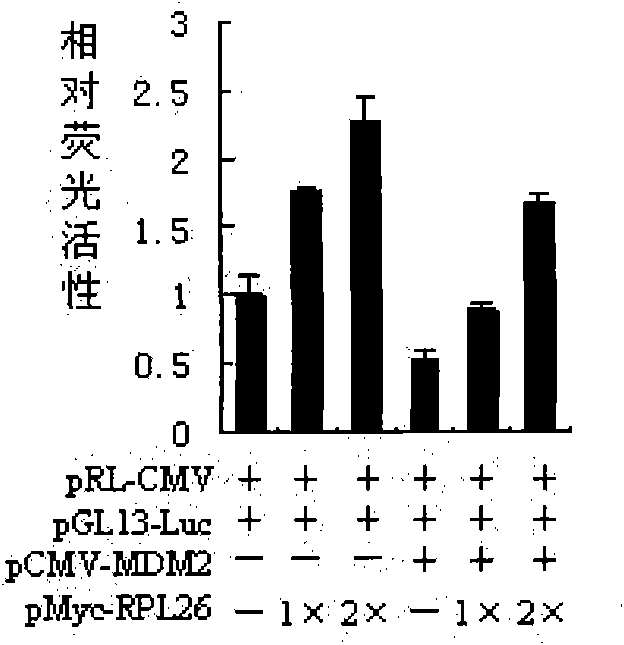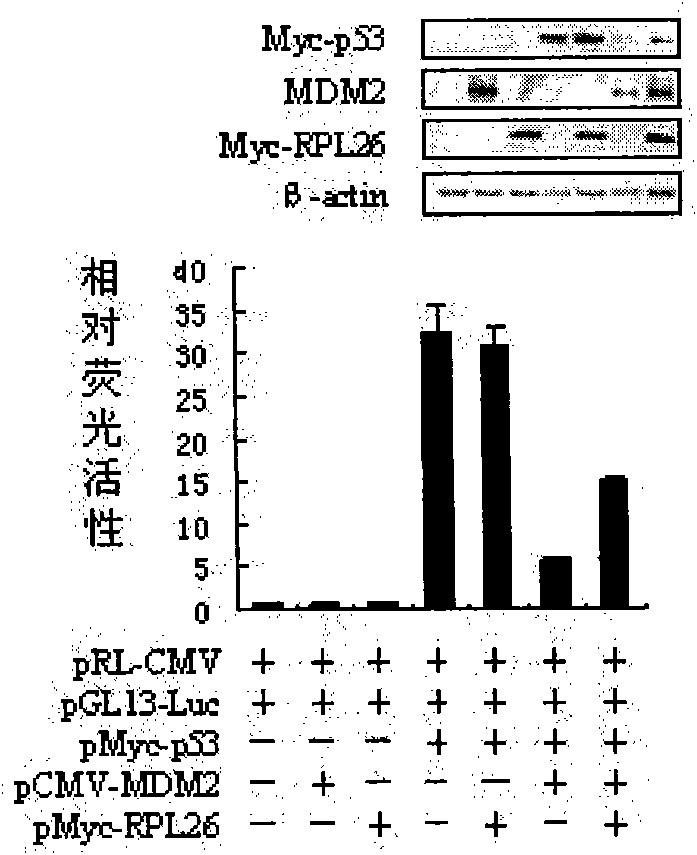Drug for inhibiting proliferation of tumor cells and application thereof
A tumor cell proliferation and drug technology, applied in the direction of antineoplastic drugs, drug combinations, pharmaceutical formulations, etc.
- Summary
- Abstract
- Description
- Claims
- Application Information
AI Technical Summary
Problems solved by technology
Method used
Image
Examples
Embodiment 1
[0026] Embodiment 1, the construction of RPL26 expression vector
[0027] According to the cDNA sequence of RPL26 (GenBank Accession No.M_000987), design the forward primer ML26-1: 5'-gtacGTCGACCatgaagtttaatccctttg-3' (the capital letter is the Sal I restriction site) and the reverse primer ML26-6: 5'- tcagGCGGCCGCttcctgcatcttctcaatg-3' (the uppercase letter is the Not I restriction site), and the adult liver cDNA library (purchased from Invitrogen) was used as a template to amplify the coding gene of RPL26 by PCR. The PCR amplified product and the pCMV-Myc (purchased from Clontech Company) vector were digested with Sal I and Not I respectively and ligated, and the ligated product was transferred into E.coli JM109 competent cells, and ampicillin resistance was used to screen positive Cloning, extracting plasmids for enzyme digestion identification, sequencing the clones with correct enzyme digestion identification results, and naming the obtained recombinant expression vector ...
Embodiment 2
[0032] Embodiment 2, the regulation of RPL26 to MDM2-p53 pathway
[0033] 1. The effect of RPL26 on the transcriptional activation activity of wild-type p53
[0034] The plasmid pGL13-Luc (Yu J, Zhang L, Hwang P M, Rago C, Kinzler K W and Vogelstein B. (1999). Identification and classification of p53-regulated genes. Proc NatlAcad Sci US A 96: 14517-14522.), pRL- CMV (purchased from Promega), pCMV-MDM2 (Zhang Y, Wolf G W, Bhat K, Jin A, Allio T, Burkhart W A et al. (2003). Ribosomalprotein L11 negatively regulates oncoprotein MDM2 and mediates a p53-dependent ribosomal-stress checkpoint pathway.Mol Cell Biol 23:8902-8912.) and the plasmid pMyc-RPL26 constructed in Example 1 above, according to figure 1 The indicated mixes were transfected with osteosarcoma cells (U2-OS cells) containing wild-type p53 (purchased from American Standard Biological Collection). figure 1 Among them, + indicates that the substance is added, - indicates that the substance is not added, 1× indicates...
Embodiment 3
[0050] Example 3, the mechanism of RPL26 affecting the MDM2-p53 pathway
[0051] 1. The effect of RPL26 on the ubiquitination of MDM2 and p53
[0052] The above plasmids pFlag-p53, pCMV-MDM2 and pHA-Ub (Zhang Y, Wolf G W, Bhat K, Jin A, Allio T, Burkhart W A et al. (2003). Ribosomal protein L11 negatively regulates on coprotein MDM2 and mediates a p53- dependent ribosomal-stress checkpoint pathway. Mol Cell Biol 23: 8902-8912.) and the plasmid pMyc-RPL26 constructed in Example 1 above, according to Figure 5 Mix as indicated and transfect H1299 cells. Figure 5 In , + means to add the substance, - means not to add the substance. In 25cm by Lipofectamine2000 transfection method 2 / 50ml culture flask for transfection, and each group of plasmids transfected 3 flasks.
[0053] After 24 hours of transfection, replace with fresh medium containing 20 μM proteasome inhibitor MG132 (purchased from Sigma Company) and continue to culture for 8 hours, aspirate the medium, wash the cel...
PUM
 Login to View More
Login to View More Abstract
Description
Claims
Application Information
 Login to View More
Login to View More - R&D
- Intellectual Property
- Life Sciences
- Materials
- Tech Scout
- Unparalleled Data Quality
- Higher Quality Content
- 60% Fewer Hallucinations
Browse by: Latest US Patents, China's latest patents, Technical Efficacy Thesaurus, Application Domain, Technology Topic, Popular Technical Reports.
© 2025 PatSnap. All rights reserved.Legal|Privacy policy|Modern Slavery Act Transparency Statement|Sitemap|About US| Contact US: help@patsnap.com



